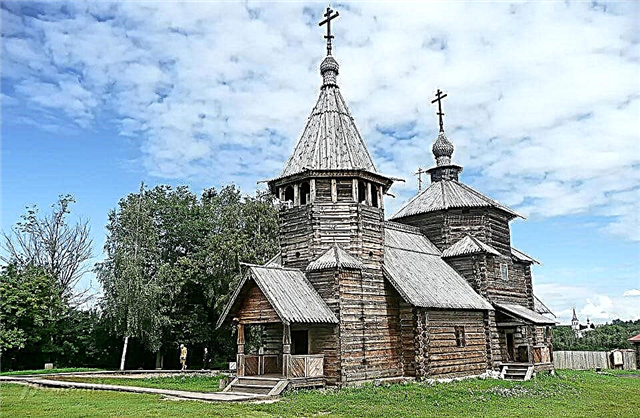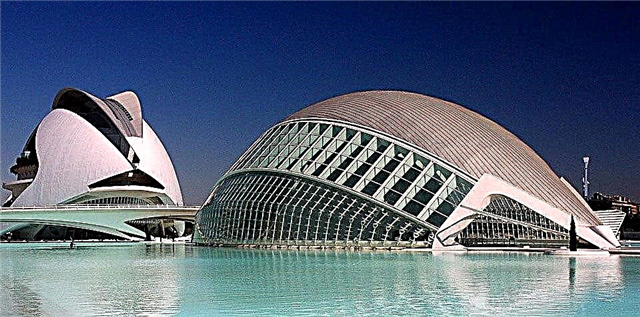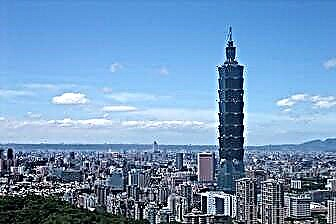Address: Russia, Yaroslavl region, Yaroslavl, Port embankment, 2
Main attractions: Church of St. John Chrysostom, Church of the Vladimir Icon of the Mother of God, bell tower, Holy Gates
Coordinates: 57 ° 36'40.8 "N 39 ° 54'21.6" E
Content:
More than one generation of talented Yaroslavl craftsmen - potters, masons, carvers and icon painters - worked to ensure that the beautiful temple complex in Korovniki would please the eyes of Yaroslavl residents and guests. An architectural ensemble of remarkable beauty is located on the right bank of the Volga, below the mouth of its right tributary, the Korotosl River. It consists of two churches - cold and warm, a bell tower and a fence with the Holy Gates, perfectly visible from the low Volga bank.
History of churches in Korovnitskaya Sloboda
The temple ensemble was built gradually - over several decades. The place where it was created has been known since the 16th century. The old settlement was first called Doilova, and later - Cowsheds. The Yaroslavl people living here bred cows, gardened, fished, and were also good artisans. Skillful potters and craftsmen lived in the settlement, producing amazingly beautiful ceramic tiles.

Temple complex in Korovnitskaya Sloboda view from the Volga
It is known that a wooden church existed in Korovniki. Its limits were consecrated in honor of John Chrysostom and the Vladimirovka icon of the Mother of God. Information about this has been preserved on an ancient bell made for the temple back in 1622.
The first brick temple, which later set the tone for the entire architectural ensemble, began to be built in Korovniki in 1649. It was a cold church dedicated to John Chrysostom. 20 years later, a second church was erected in honor of the Vladimir Icon of the Mother of God. The bell tower, which occupies a central place in the temple complex, was built even later, in the 1680s. And the whole composition was completed by a low church fence, the Holy Gates above which appeared in the last years of the 17th century.
At the beginning of the last century, the famous Russian photographer Sergei Mikhailovich Prokudin-Gorsky traveled to ancient Russian cities. Thanks to the work done by him, today we can admire the views of the temples in Korovniki, captured on very rare color photographs at that time. They show that the facades of the churches in those days were whitewashed, and the decorative red-brick "pattern" stood out in contrast against the background of strict light-colored walls.

Temple complex in Korovnitskaya Sloboda
During the years of Soviet power (since 1935), the churches remained closed for a long time and were used for warehouses. Now the Old Believer community is engaged in the restoration of the temple complex.
Church of St. John Chrysostom
The first to appear in the Korovnitskaya Sloboda was the Zlatoust Church. Its construction took 5 years, and the church was consecrated in 1654. The rich Yaroslavl merchants, the Nezhdanovskiy brothers, became the temple teachers. The benefactors were generous, and the church turned out to be luxurious. Especially beautiful were the poly-colored ceramic tiles, which were used to decorate the outside of the temple.
And although for three and a half centuries the Zlatoust Church was repeatedly rebuilt, its original proportions and decor have not been lost, and continue to delight lovers of Old Russian architecture to this day. Moreover, later reconstructions made this temple even more elegant, and it is rightfully considered one of the most beautiful temples not only in Yaroslavl, but throughout Russia.
The five-domed church was built without a basement and is surrounded by a one-story gallery. She was the first temple in the city, which was erected "in a new way" - without the lower floor. Therefore, in order not to violate the general harmony, the five-domed was made more elevated than was customary in the 17th century. With the side-altars taken out, the Church of Zlatoust is very proportional and looks like a helmet. And its slender silhouette from the side of the river makes a particularly strong impression.

Church of St. John Chrysostom
Outwardly, this church is decorated in the tradition of the "Russian pattern", which was characteristic of the temple pre-Petrine architecture. However, the real fame was brought to her by a large ceramic frame made of five-color glaze, fixed on the altar part. This is a real work of art, made with great skill! The famous platband is quite large and was made 40 years after the construction of the temple.
Inside you can see an old carved iconostasis, which Yaroslavl craftsmen carved at the turn of the 17th-18th centuries, as well as picturesque frescoes. Today, Old Believers' services are held in the Zlatoust Church.
Temple of the Vladimir Icon of the Mother of God
The parishioners needed a church for worship in the cold season, and the Vladimir Church became the second in Korovniki (1669). The architects who erected this temple set the task of obtaining a harmonious ensemble with the church of St. John Chrysostom that already existed in the settlement. The task was successfully solved, but the new church turned out to be very high. It was not easy to heat such volumes in winter. Therefore, after some time, the temple was divided into two floors. Services were held downstairs, and the upper floor was used as an attic.
Vladimirskaya church was built south of Zlatoustinskaya. And on the western side, a refectory, traditional for winter temples, was added to it. Although in size and proportions the second church almost copies the first temple, it looks much more modest, since it does not have porches, side-chapels and luxurious decor.

Temple of the Vladimir Icon of the Mother of God
The interior of the Vladimir Church was painted only at the end of the 18th century. It is noteworthy that most of the paintings were done by local master-isographers Vasily Sarafannikov and Efim Soplyakov. The latter was the grandson of the famous Alexei Soplyakov, the author of the frescoes in the Zlatoust Church. In the 19th century, a side-altar was added to the Vladimir Church, consecrated in honor of Nicholas the Wonderworker.
In 2000, the altar of the church was consecrated, and now the Old Believers' services are held there. More recently, the windows of the temple were decorated with modern colored stained-glass windows.
Yaroslavl candle
The center of the entire temple composition is occupied by a high bell tower, which rises to the sky by 37 m. The townspeople call this slender tent-roofed structure “Yaroslavl candles”. Agree, there are not many bell towers with their own names in Russia. The "candle" stands to the west of both temples, at the same distance from each. Its separate position was conceived from the very beginning. The base of the bell tower is a laconic octahedral pillar, as if growing out of the ground. It is crowned with an openwork tent with three rows of cut lucarnes or ear holes and an expressive tier of bells. Their arches are also richly decorated with brick semi-columns and end with picturesque kokoshniks.
The decor of the base of the bell tower, on the contrary, is very modest and consists of only a few small windows. It is separated from the lavishly decorated tent by a wide belt of brick "pattern" with colored tiled inserts.

Bell tower
In former times, the "Yaroslavl candle" housed five bells, cast at the Ural factories, which belonged to the Demidovs. The largest of them weighed 200 pounds. A powerful bell ringing was heard far around. In the 20th century, the Yaroslavl candle stood for several decades without bells. And finally, thanks to the efforts of the parishioners, in September 2015, the new bells were hoisted in their rightful place, and the bell tower began to sound again.
Holy gates
The low fence became the final construction of the temple complex, which gave it completeness and integrity. The Holy Gates were made at the very end of the 18th century in the tradition of the “Naryshkin Baroque”. They are placed in line with the bell tower.The gate, like all the buildings of the ensemble, is richly decorated with brick "ornamental" and glazed tiles. The builders made sure that from the side of the Volga the Holy Gates looked rather squat, emphasizing the majesty and solemnity of the two main temples.
The current state of the temple complex and the mode of visiting it
Today the churches in Korovniki are used for Old Believer services. In addition, restoration work is underway here. It is not easy to get inside the temples, especially for ordinary tourists.

Holy gate, church of St. John Chrysostom
How to get there
The temple complex is located in Yaroslavl at 2 Portovaya Embankment, not far from the banks of the Volga.
By car. The federal highway M8 leads from Moscow to Yaroslavl. Within the city limits, it is called Moskovsky Prospekt. Before reaching the bridge over the Korotosl River, you need to turn right from it - onto Malaya Proletarskaya Street. Along it, as well as along the streets of Melnichnaya and Zlatoustinskaya after 1.7 km, you can go to the temples of the Korovnitskaya Sloboda.
By train. From Moscow to Yaroslavl, express train trains reach in 3 hours 16 minutes. The journey by regular train takes from 4 to 5.5 hours. From the Moskovsky railway station in Yaroslavl, the distance to the temple complex is 2.7 km. You can walk here or take a taxi.











